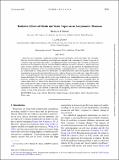Radiative effects of clouds and water vapor on an axisymmetric monsoon
Abstract
Monsoons are summertime circulations shaping climates and societies across the tropics and subtropics. Here the radiative effects controlling an axisymmetric monsoon and its response to climate change are investigated using aquaplanet simulations. The influences of clouds, water vapor, and CO2 on the axisymmetric monsoon are decomposed using the radiation-locking technique. Seasonal variations in clouds and water vapor strongly modulate the axisymmetric monsoon, reducing net precipitation by approximately half. Warming and moistening of the axisymmetric monsoon by seasonal longwave cloud and water vapor effects are counteracted by a strong shortwave cloud effect. The shortwave cloud effect also expedites onset of the axisymmetric monsoon by approximately two weeks, whereas longwave cloud and water vapor effects delay onset. A conceptual model relates the timing of monsoon onset to the efficiency of surface cooling. In climate change simulations CO2 forcing and the water vapor feedback have similar influences on the axisymmetric monsoon, warming the surface and moistening the region. In contrast, clouds have a negligible effect on surface temperature yet dominate the monsoon circulation response. A new perspective for understanding how cloud radiative effects shape the monsoon circulation response to climate change is introduced. The radiation-locking simulations and analyses advance understanding of how radiative processes influence an axisymmetric monsoon, and establish a framework for interpreting monsoon–radiation coupling in observations, in state-of-the-art models, and in different climate states.
Citation
Byrne , M P & Zanna , L 2020 , ' Radiative effects of clouds and water vapor on an axisymmetric monsoon ' , Journal of Climate , vol. 33 , no. 20 , pp. 8789-8811 . https://doi.org/10.1175/JCLI-D-19-0974.1
Publication
Journal of Climate
Status
Peer reviewed
ISSN
0894-8755Type
Journal article
Description
Funding: This project has received funding from the European Union’s Horizon 2020 research and innovation programme under the Marie Skłodowska-Curie Grant Agreement 794063 and the UK Natural Environment Research Council’s Grant NE/R000727/1.Collections
Items in the St Andrews Research Repository are protected by copyright, with all rights reserved, unless otherwise indicated.

